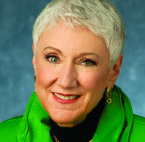Hadassah
President's Column
President’s Column: Hadassah 101
 February 2013 marks the 101st anniversary of Hadassah’s founding. If our Centennial reminded us of our rich history, the beginning of our second century focuses our attention on the future. A dynamic organization that wants to stay relevant needs to constantly plan, anticipate, change and adapt—and never lose sight of its mission.
February 2013 marks the 101st anniversary of Hadassah’s founding. If our Centennial reminded us of our rich history, the beginning of our second century focuses our attention on the future. A dynamic organization that wants to stay relevant needs to constantly plan, anticipate, change and adapt—and never lose sight of its mission.
Our newest anniversary may not have the historic significance of 100, but Hadassah 101 has the benefit of
reminding us of the basics. Why are we here and what is our mission? What would remain at our core if we stripped everything else away?
At the heart of our mission are the goals of strengthening the Jewish people, building Israel, fostering close relations between Israel and the United States and advocating for health care and women’s rights.
The projects we have built and maintained over the past century—first and foremost our medical work—have given us a sterling reputation and a key role in both the American Jewish community and in the Jewish state. As important as the projects are, however, they are more the “how” of our existence than the “why.” What defines us is our mission of service.
Looking backward, history always appears clear and linear. It is worth noting that 100 years ago, in February 1913, the first two Hadassah nurses were in transit from New York to Jerusalem. All the rest of our story—building the medical infrastructure of the future state, working with at-risk children and launching a variety of school projects, not to mention wars, the founding of modern Israel, many successes and numerous financial challenges—were well in the future. The mission was clear, but events were unknowable.
Hadassah’s second century will be as unpredictable as the first. Even looking back, it is easy to miss some of the essentials that help us understand how to move forward. For example, our portfolio of projects, programs and institutions has changed constantly. Between 1912 and 1948, Hadassah built a network of more than 130 hospitals, clinics, dispensaries and infant welfare stations across the Land of Israel because there was a need and we had the resources to fill it. Once the state was born, we turned most of those institutions over to Israel’s national and municipal governments and concentrated on medical care and medical education in Jerusalem.
Our nonmedical education programs also changed over the decades as Israel’s needs changed. We went from vocational schools to opening Israel’s first community college. But the void we filled in a struggling young nation does not exist in a first-world society with a wide range of higher education choices—including the college we founded.
Our relationship with Young Judaea has evolved through several stages over the past 75 years. Though it is no longer under our roof, we still have a relationship with the movement, and I am sure we will remain partners in connecting youth to Zionism long into the future.
Even in the Hadassah Medical Organization, the dynamics have changed repeatedly over the years. Just as many graduates of our medical, nursing and dental schools go on to serve in, or lead, other health care institutions, so do many hospitals and clinics across Israel today trace their origins to the Hadassah medical network.
It might have seemed that Youth Aliyah, designed to shelter and educate refugee children from Nazi-occupied Europe, would have no raison d’être after the end of World War II. But its mission was transformed into one of educating children of postwar immigrants and disadvantaged Israeli families.
Changes in our project structure—even dramatic ones—have been part of our story since the beginning. As always, Hadassah continues to be responsive to the needs of Israel and the Jewish people. The past is something we honor. The future is something we plan for and adapt to. Our generation represents an advanced version of Hadassah, but it’s always useful to take a glance back at the Hadassah 101 textbook.










 Facebook
Facebook Instagram
Instagram Twitter
Twitter
Leave a Reply